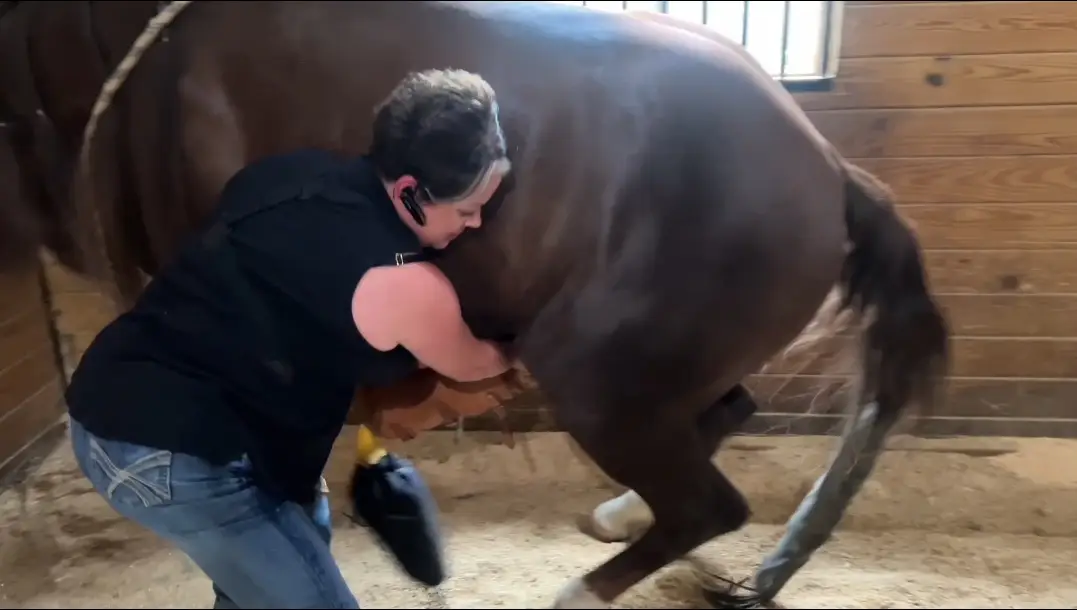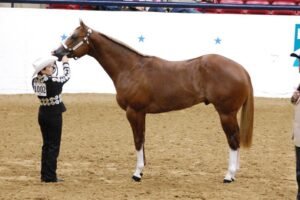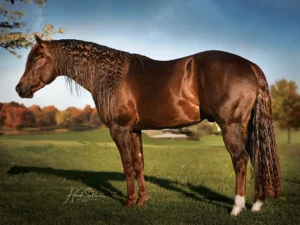The Ultimate Guide to Ground Collection of Stallions: A Safe and Effective Breeding Method
Introduction to Ground Collection
When most people think of breeding a stallion, they think of live cover, pasture breeding, or traditional collection off a phantom for artificial insemination. Ground collecting a stallion is a method of collecting semen without the use of a phantom or a live mare for mounting. This method is an excellent choice for stallions that have sustained injuries to their backs, hocks, stifles, or tendons and ligaments. It is simple and effective, and most stallions can easily be cross trained for ground collection, collecting off a phantom, and live cover, giving stallion managers flexible options to provide breeding services for their customers.
Advantages of Ground Collection for Stallions
Ground collection is particularly beneficial for stallions recovering from injuries or those who have anatomical or behavioral issues that make traditional methods difficult. By removing the need for mounting a mare or phantom, it greatly reduces the risk of re-injury and can be a less stressful process overall. Additionally, once a stallion is trained for this method, it can be collected in various settings, giving breeders a flexible tool to accommodate different breeding scenarios.
Essential Tools and Equipment Needed
- Helmets
- Leather halter
- 30-inch stallion chain with rubber stopper attached to a 6-foot lead
- Stainless steel bucket
- Plastic bucket liner
- Viva Signature Cloth paper towels
- Pool noodle
- Artificial Vagina
- Sterile, non-spermicidal lubricant
- Collection bottle and cover
- A feed scoop with mare urine-soaked shavings
- A mare
- Three handlers – 1 for the mare and two for the stallion
Step-by-Step Training Process for Ground Collection
Put your helmets on first! Horses are unpredictable, especially in the breeding shed. It’s very easy to get struck in the head accidentally by a stray hoof not even directed at a handler, or to have a stallion try to bite your head and scalp you. While these situations are rare, they can happen. SAFETY FIRST! Training for Ground Collection typically takes three 15-minute sessions for experienced handlers and up to five, 15-minute sessions for less experienced handlers (McDonnell SM, Love CC, 1990). I like to keep everything streamlined by using the same stimulus and method each time to create reliable behavior and results. However, I do not always use the same equipment or location for collection once they become trained in the method. This helps to instill two things in the stallion: manners, and reliable collection anywhere, at any time.
The first thing one must be sure of is that the stallion will stand quietly while being cleaned. Some stallions, when aroused, will squeal, and kick out at the handler, while having their penis grasped and cleaned before breeding. I circumvent this issue with several short training sessions using a pool noodle. The pool noodle is gently rubbed up and down the stallion’s hind legs, along his sheath and testicles, taking care not to hit or “rub” the testicles and sheath too hard, or create too much friction on the delicate skin. The handler will do this until the horse stands quietly for at least two sessions. Once this has been accomplished, the handler can move on to making sure he or she can touch the sheath, penis, testicles, and hind legs with his/her hands and clean paper towels, without the stallion kicking out for several sessions. I only move on to teaching him to collect once he remains calm and stands quietly during this process. This is an important first step to ensuring both stallion and handler safety. This teaches the stallion to have patience when aroused, creating a stallion that waits for permission to breed rather than a stallion that demands to breed.
Classical Conditioning Techniques
Moving on to teaching the actual collection method, it is much like the classic Pavlov’s Dogs method of classical conditioning. Stimuli, such as the visual of the mare, an olfactory stimulus such as a rag soaked in mare urine, or a small bucket with urine-soaked shavings is paired with the touch of the warm, wet paper towel that will be used to clean the penis before collecting. I start by placing my lip chain on the stallion. This is a 30-inch stud chain that runs through the left-side halter ring, over the top gums, through the right-side halter ring and clipped onto the top right-side ring of the halter. I keep a round, rubber stopper on my stud chains that can be snubbed up against the left-side ring of the halter. This prevents the chain from slipping out of place and keeps constant, calming, and steady pressure over the gums. Many stallions may not require a chain for breeding, however, when ground collecting one needs to remember the stallion can easily reach around to his shoulder and grab you in the middle of the back, or even attempt to scalp you if he gets frustrated. The use of the lip chain is a safety precaution, and I will use it even on the best-behaved stallions. It only takes one time to be caught off-guard and injured.
The Cleaning Protocol Before Collection
Once I have the mare in sight, and the urine-soaked shavings where the stallion can smell them, I touch the wet paper towel to the stallion’s sheath and wait for him to “drop” his penis from the sheath so that I may clean the penis. It is important not to scrub, rub, or use soaps of any kind when cleaning the stallion. Instead, grasp the penis, and from the ring down, squeeze the excess water from the paper towels over the shaft of the penis to remove debris and smegma paying attention to the head of the penis and around the urethra to blot debris away. Never rub as you can damage or tear the delicate skin and cause it to bleed. Once free of debris, gently blot the entire penis with dry paper towels to remove all excess water and ensure the skin is dry. Water is spermicidal to sperm, so any water remaining on the penis could flow into your collection bottle once you collect and contaminate and kill off the sperm. Once the stallion is properly cleaned, and the penis is fully erect, it is time to collect. Please note that some stallions will retract into the sheath after cleaning. This is normal. Re-tease the stallion with the mare visual and the urine-soaked shavings until he drops and becomes fully erect again.
Performing the Collection Safely
Ensure the stallion handler is at the head of the stallion, with a firm left hand on the lead shank and the right hand placed on the stallion’s shoulder. The stallion will naturally want to walk forward during the first couple of times of learning this method until he finds his rhythm and something to brace himself against. Grasp the stallion’s penis and place it into the artificial vagina (AV). Once the stallion enters the AV, his instinct is to thrust. However, some stallions may require one or two manual stimulations with the AV bumping against the base of the penis to encourage him to begin thrusting. After 5-7 coordinated thrusts, the stallion will ejaculate. The flagging of the tail notes this. Once this occurs, the collection is complete and the processing of the semen for shipment or onsite artificial insemination can begin.
What to Expect During Initial Sessions
The first few times the stallion is ground collected he should be allowed to walk forward so that he can maintain his balance while thrusting. However, the stallion handler should keep a hand firmly on the stallion’s shoulder. Although the handler will not be strong enough to give the stallion the true brace he will be looking for, this conditions the stallion for when he becomes adept with the method and can use a wall, or corner to brace himself against while thrusting. The handler collecting the stallion should take care to brace his left shoulder against the barrel of the stallion, with his left hand on the AV, and right hand free to potentially grasp and steady the base of the penis to ensure the stallion ejaculates and remains in the AV. Once the stallion has a few ground collection sessions under his belt, you can allow him to brace his chest or shoulder against a wall or collect him in a set of stocks. Taught correctly, most stallions are later able to be collected with no mare, and one handler.
Phasing Out Stimuli Gradually
Once the stallion has been collected a few times from the ground, stimuli can begin to be phased out. For example, after the fourth or fifth collection, I like to phase the mare out and only allow the stallion to tease to urine-soaked shavings, or urine on a paper towel. Personally, I have used urine from mares in estrous, anestrous, and even from geldings. With some stallions, the type of urine used doesn’t matter because they are already solid in the technique. This season my tease mare was in foal, so even the visual of her was not enticing enough for my stallion to tease. I have used my Shetland pony stallion as the visual aid this season for every collection, without issue. Some seasons, I won’t use any stimuli at all for teasing, and instead just use the warm wet paper towel, touch it to his sheath and allow him to drop and become erect. This behavior is achieved through multiple sessions of training systematically, with the same approach, and pairing the same stimuli, then phasing each stimulus out, one by one, until the stallion drops on cue. I enjoy this method more because it’s a time saver. However, occasionally, he still requires a visual or olfactory stimulus. This is generally the case if we have a heavy collection week and I need to collect him every day.
Semen Output and Quality Considerations
In some instances, ground collection can yield partial ejaculates or lower total sperm per ejaculate. In one study of over 500 stallions trained to ground collect, research shows that “stallions took significantly longer to reach ejaculation with ground collection and had a 25% decrease in total sperm per ejaculate, but the motility was not affected” (Newkirk, 2016). It is important to know your stallion’s daily output capacity which is directly related to the testicular circumference. You can determine this by using a set of calipers to determine testicular circumference and plugging the measurement into a formula. Ground collection is the only method I use for my in-house and haul-in stallions. In my experience, I have noted less gel, greater motility, and less resistance from the stallion, as well as fewer jumps of the AV. However, we do have some days where a decrease in total sperm output is seen. My in-house stallion can produce an average of 12 to 15 billion total sperm per ejaculate, but some days he may only output 8–10 billion. Factors such as heat, fatigue, and pain will affect the output as well, even if collected from a phantom. Even on days when total sperm output is decreased, we are still able to ship plenty of doses due to no effect on progressive motility. On average, it takes me roughly two-and-one-half minutes to tease, clean the stallion, and collect, from start to finish.
Efficient Collection Workflow
Many stallion handlers like to keep everything different for collection, from the halter and equipment to the collection area. I, however, do not. I collect my stallion in his stall, in the same halter and equipment I use every day, tied to the same tie I use to tie him for grooming or anything else I want to do with him. Most people, erroneously, believe the stallion should be trained with different equipment so the stallion understands when he is allowed to behave like a stallion, and when he is not. I have found, with ground collection, that if the training is done properly, typical stallion behavior such as screaming, striking, prancing, etc. becomes nearly nonexistent. The stallions I train for collection are expected to behave like gentlemen whether I am collecting, grooming, or working them. I have found that using the same equipment for all my tasks eliminates anticipatory behavior from the stallion. If he doesn’t know whether he will be collecting that day, or working in the arena, there is nothing for him to anticipate, and it results in a much quieter stallion. Most of the stallions I have trained for collection don’t even nicker. They stand patiently to be cleaned, and as soon as I slip the AV on, they do their job and it’s all complete in about 30 seconds. All without abusive reprimands or laying a hand on them. I can immediately turn them loose in their stall, and they can go back to eating and I can go process the collection for shipping.
Tips for Long-Term Training Success
It is important not to over-reprimand the stallion in the breeding shed. Squealing, striking, whinnying, and prancing are all normal stallion behaviors and are acceptable behaviors if they do not turn into dangerous behaviors. Reprimands should be quick, short, and to the point (less than two seconds long, and less than two or three seconds after the behavior occurs). Never beat on a stallion, especially in the breeding shed. The stallion will remember your behavior, and he will wait to exact his revenge when you least expect it, and they will wait for months and years if they must. The rule is to be firm, but fair. Firm pressure (not yanking or jerking) on the lip chain and a redirection of the task is generally a welcomed reprimand, and one they understand well, and accept. Stallions do not need to be raging hormonal monsters for collection. It is often the human reprimand behavior that leads them to be aggressive and misbehave in the long run. Take the time to train them correctly and you’ll have a wonderful breeding stallion for years to come.
Appropriate Discipline in the Breeding Shed
It is important not to over-reprimand the stallion in the breeding shed. Squealing, striking, whinnying, and prancing are all normal stallion behaviors and are acceptable behaviors if they do not turn into dangerous behaviors. Reprimands should be quick, short, and to the point (less than two seconds long, and less than two or three seconds after the behavior occurs). Never beat on a stallion, especially in the breeding shed. The stallion will remember your behavior, and he will wait to exact his revenge when you least expect it, and they will wait for months and years if they must. The rule is to be firm, but fair. Firm pressure (not yanking or jerking) on the lip chain and a redirection of the task is generally a welcomed reprimand, and one they understand well, and accept. Stallions do not need to be raging hormonal monsters for collection. It is often the human reprimand behavior that leads them to be aggressive and misbehave in the long run. Take the time to train them correctly and you’ll have a wonderful breeding stallion for years to come.
Case Studies and Practical Experience
Most of the stallions I have trained for collection don’t even nicker. They stand patiently to be cleaned, and as soon as I slip the AV on, they do their job and it’s all complete in about 30 seconds. All without abusive reprimands or laying a hand on them. I can immediately turn them loose in their stall, and they can go back to eating and I can go process the collection for shipping. This behavior is achieved through multiple sessions of training systematically, with the same approach, and pairing the same stimuli, then phasing each stimulus out, one by one, until the stallion drops on cue. This consistency results in a much quieter, more cooperative animal overall, ready to work safely and efficiently in a variety of settings.
Conclusion
Ground collection is a safe, flexible, and highly effective method for breeding stallions, especially those with physical limitations or those requiring behaviorally controlled conditions. With proper training, consistency, and patience, stallions can be collected safely without the need for a phantom or mare. The method improves manageability, can yield high-quality semen for artificial insemination, and contributes to a calmer, more obedient breeding experience. Stallion managers who take the time to correctly implement ground collection methods can enjoy reliable, efficient results without compromising the health or safety of the stallion or handlers.
Resources
Newkirk, Dr. E. N. (2016, August 10). Ground collection of the stallion. Select Breeders. June 20, 2024, https://info.selectbreeders.com/blog/ground-collection-of-the-stallion
One response to “The Top 10 Ground Collection Secrets Every Stallion Owner Should Know”

Perfect just what I was looking for! .





Leave a Reply